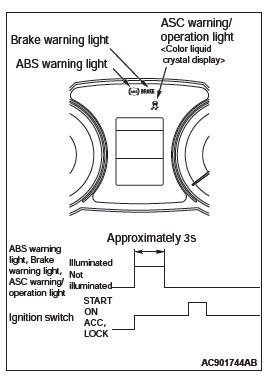Mitsubishi Outlander: Active Stability Control System (ASC)
Service Specifications

Diagnosis
INTRODUCTION TO ASC DIAGNOSIS
The active stability control system (ASC) operates differently from conventional brake systems. These differences include sounds, sensations, and vehicle performance that owners and service technicians who are not familiar with ASC may not be used to.
Some operational characteristics may seem to be malfunctions, but they are simply signs of normal ASC operation. When diagnosing the ASC system, keep these operational characteristics in mind.
Inform the owner of the kind of performance characteristics to expect from an ASC-equipped vehicle.
ASC DIAGNOSTIC TROUBLE CODE DETECTION CONDITIONS
ASC diagnostic trouble codes (ASC DTCs) are set under different conditions, depending on the malfunction detected. Most ASC DTCs will only be set during vehicle operation. Some ASC DTCs will also be set during the ASC self-check immediately after the engine is started.
When you check if an ASC DTC will be displayed again after the DTC has been erased, you should duplicate the ASC DTC set conditions. Depending on the detection timing and set conditions for the specific ASC DTC, you must either drive the vehicle or turn the engine off and restart it. To set the proper conditions for that DTC again, refer to "ASC DTC SET CONDITIONS" for each ASC DTC that you are trying to reset.
ASC DIAGNOSTIC TROUBLESHOOTING STRATEGY
Use these steps to plan your diagnostic strategy. If you follow them carefully, you will be sure that you have exhausted most of the possible ways to find an ASC fault.
1. Gather information about the problem from the customer.
2. Verify that the condition described by the customer exists.
3. Check the vehicle for any ASC DTC.
4. If you cannot verify the condition and there are no ASC DTCs, the malfunction is intermittent. Refer to GROUP 00, How to use Troubleshooting/Inspection Service Points − How to Cope with Intermittent Malfunctions.
5. If you can verify the condition but there are no ASC DTCs, or the system cannot communicate with the scan tool, check that the basic brake system is operating properly.
- If the basic brake system is not operating properly, refer to the GROUP 35A, Basic Brake System Diagnostic troubleshooting strategy.
- If the basic brake system is operating properly.
6. If there is an ASC DTC, record the number of the DTC, then erase the DTC from the memory using the scan tool.
7. Recreate the ASC DTC set conditions to see if the same ASC DTC will set again.
- If the same ASC DTC sets again, perform the diagnostic procedures for the DTC.
- If you cannot get the same ASC DTC to set again, the malfunction is intermittent. Refer to GROUP 00, How to use Troubleshooting/Inspection Service Points − How to Cope with Intermittent Malfunctions.
ABS WARNING LIGHT, ASC WARNING/OPERATION LIGHT AND BRAKE WARNING LIGHT CHECK
Check that ABS and brake warning light, ASC warning/operation light illuminate as follows.
NOTE: The brake warning light is used as a warning light for parking brake, brake fluid level, and EBD control.
1. When the ignition switch is turned to the ON position, ABS and brake warning light, ASC warning/operation light illuminate.
2. The ABS and brake warning light, ASC warning/operation light illuminate for three seconds*1 and then turn OFF*2.
3. Otherwise, check the diagnostic trouble code.

NOTE:
- *1: The ABS warning light may stay ON until the vehicle speed reaches 10 km/h. As far as ABS-ECU stores any diagnostic trouble code related to the wheel speed sensor malfunction or the motor malfunction as past trouble, ABS-ECU continues illuminating the ABS warning light until it verifies that the malfunction for that code is resolved (start-up check).
- *2: The brake warning light does not turn OFF when the parking brake is applied or the brake fluid level is lowered.

